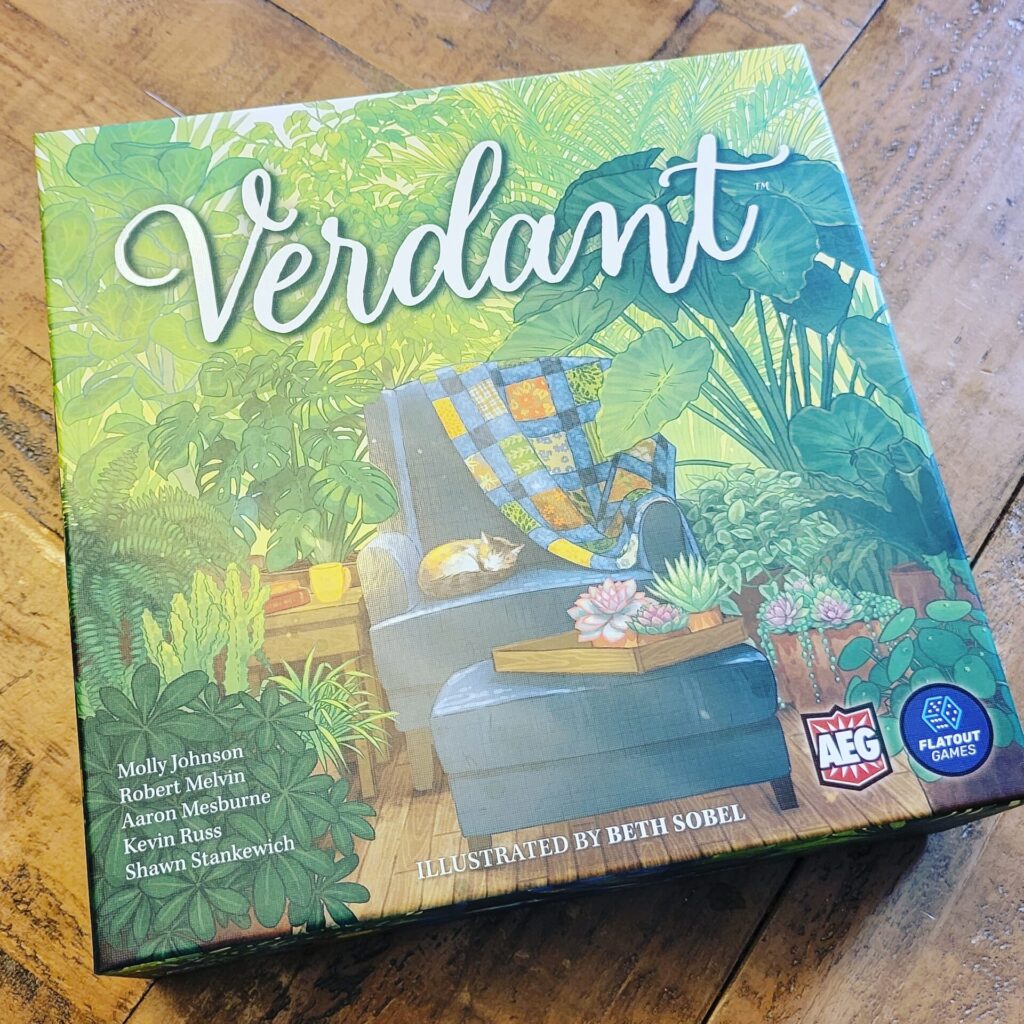
Name: Verdant
Year of Release: 2022
Player Count: 1 — 5 Players
Playing Time: 30 — 40 minutes
Designer: Molly Johnson, Robert Melvin, Aaron Mesburne, Kevin Russ, & Shawn Stankewich
Publisher: Flatout Games
Primary Mechanisms: Open Drafting, Pattern Building, Grid Coverage, Tile Placement
Weight (According to boardgamegeek.com): 2.11
Overview
What does theme mean in the context of modern board games? Clicking on the second Google result landed me at a 2012 BoardGameGeek forum posting that had 43 posts discussing this conundrum, all with slightly varying thoughts and descriptions. For me, theme describes the topic of the game, that central idea that all the artwork, flavor text, atmosphere points towards. I see a lot of people talking about themes sometimes being “pasted” on. I believe this to mean that the game could eliminate the theme altogether and instead replace everything with generic symbols and numbers and still be playable. Honestly, this has never bothered me because I can’t say that I’ve ever played a board game about, let’s say farming for example, and once I’m done, felt like I spent hours toiling away in the dirt or feeding the chickens in the chicken coop. I won’t typically pick to play a game based on theme alone but if I have to choose between multiple games, it helps to inform that decision.
OK, so why all this talk about theme? I say all that because I’ve explained Verdant to a few people I work with, and their initial reaction is along the lines of “never heard of a board game about growing plants before…” That kind of made me pause because it’s not as if Verdant feels anything like arranging potted plants in your house but that is the theme of the game. All of the artwork, components, and just general breeziness of the game locks in perfectly with that feeling you might get whilst pruning, fertilizing, and feeding to help your little plants succeed and hope that the sunlight, water, and the plant itself can do the rest.
What all is included with Verdant? Let’s open the box and see.
Rulebook & Components
I will probably mention the game Cascadia a few times in this review. Not because the games are very similar, but because the same teams worked on both of them and if you are aware of the hard work and love that was put into the former game, you’ll understand about the latter. The rulebook is a beautiful, full-color, 20-pager that deftly covers the ins-and-outs of both the multiplayer version as well as the tight solitaire game. There is no lack of examples and diagrams to ensure that users can pick up and play the game quickly.
Much like Cascadia, the last few pages of the Verdant rulebook are dedicated to the Achievement System. This system sets up a multitude of scenarios (some within the solo game and some rule changes for multiplayer games) that players tick off as they complete. I loved this in Cascadia, and I love it equally here. As a gamer who tends to play a lot of solo versions, this type of system keeps me coming back for more challenges time and time again in the future.
Similar to the game Abyss, the majority of components you’ll be receiving are decks of cards. There are 60 unique Plant Cards as well as 60 unique Room Cards. Additionally, you’ll get 10 Plant Goals, 10 Room Goals, and 10 Item Goals which are cards that can be used in the Advanced Version to increase the scoring conditions. All of the cards are beautifully illustrated by Beth Sobel. The iconography and colors used are easy to follow and there should never be any question on what a card means.
To supplement the decks of cards, you’ll also receive a varying number of different tokens. Some, like the 45 Nurture Tokens or the 45 Item Tokens, will be dumped into and mixed up within the Verdant emblazoned cloth bag. Others, such as the Green Thumb Tokens or the Verdancy Tokens, will be placed in piles to be used as a bank during the game. Lastly, there are 36 Pot Tokens (split into four categories: Concrete, Wood, Ceramic, and Terra Cotta) which will be used in every game but a different amount of each will be placed on the table dependent on the player count.
Most of the tokens are normal cardboard tokens as you would find in many games, but the Verdancy Tokens are nice, thick, wooden versions (though this might only be in the Kickstarter variant?) Much like the cards, the Item Tokens are vibrantly illustrated. Unfortunately, the Nurture Tokens are pretty plain and just slapped on top of a drab green background. These almost seem like an afterthought as they really don’t mix with the brightness that the rest of the game conveys. All-in-all though, everything you receive within the box is wonderfully produced and I believe that all players will be happy with this aspect of the game.
Now let’s take a look at how to set up and play Verdant.
Set Up and Gameplay
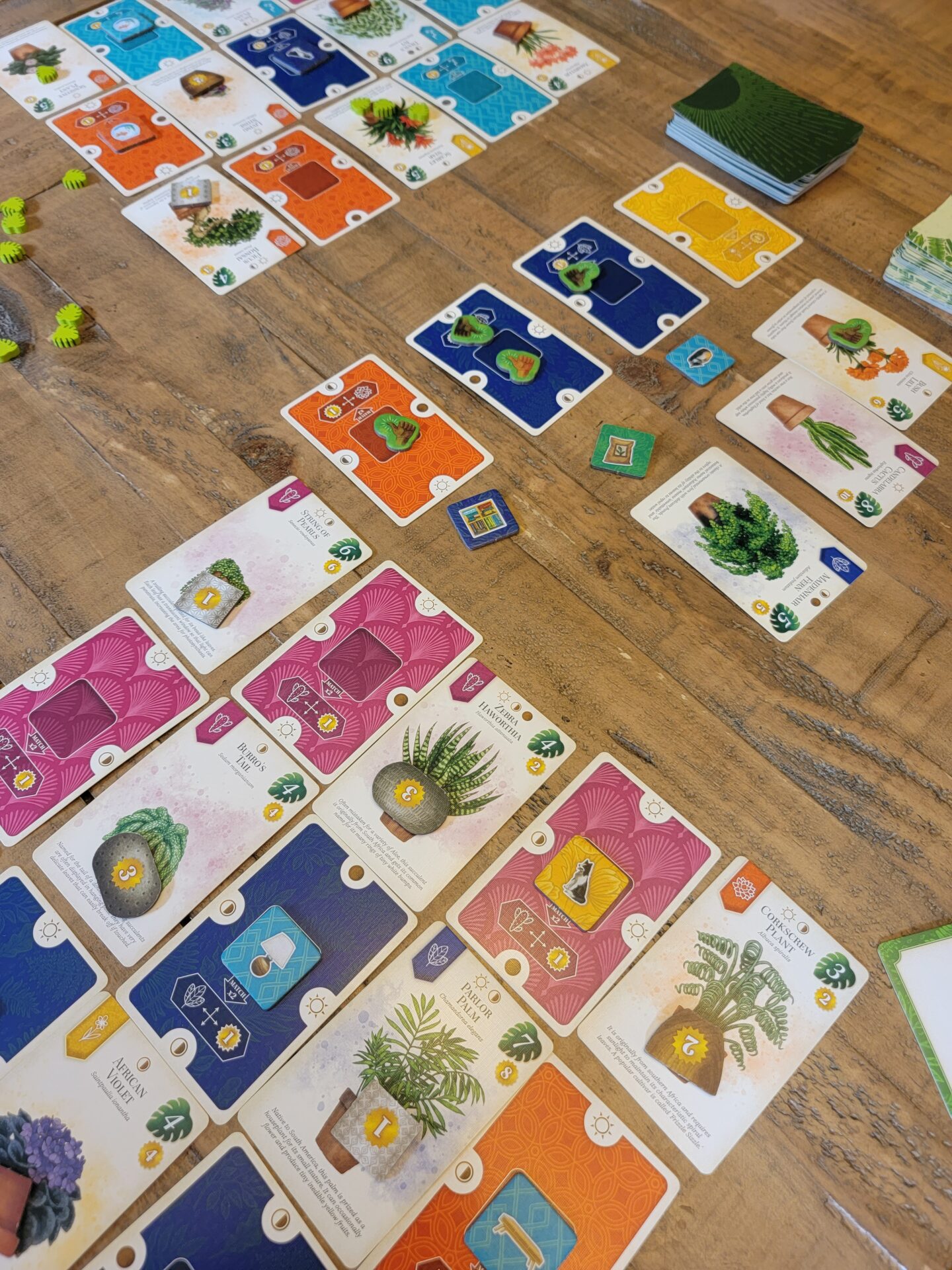
Set up between the normal multiplayer version and the solo variant are almost identical, with only minimal changes. I enjoy when a game can pull off this symmetry as players don’t have to learn a totally different set up to play both versions. Players will start by forming what the Market. This is a row of four Plant Cards, four randomly drawn tokens from the bag, and four Room Cards. The plant row is placed above the item row which is placed above the room row, creating three rows and four columns. If you’re playing the solo version, the one change enters here, where you’ll take four Concrete Pots and place them above each column. If you’re playing the multiplayer version, you’ll just keep the posts stacked in a pile at the side of the table. All that is left to do is create piles of the Verdant Tokens and Green Thumbs, and then to deal out one room and one plant to each player.
Before deciding how to place your starting plant and room, you should probably understand what the point of Verdant even is. Players will be creating a 3×5 grid (three high, five wide) of cards, alternating between Plant Cards and Room Cards as you move left to right, up to down. There are five colors within the game and each Room Card is marked by one of these colors. Additionally, each Plant Card is part of one type of plant, with each one matching one of the room’s colors. Fuchsia is Succulent, yellow is Flowering, blue is Foliage, teal is Vining, and orange is Unusual. These Room Cards have a Lighting Conditions on each side of the card, ranging between Full Sun, Semi-Shade, or Shade. There is also a blank square in the middle of the room that can hold the Item Tokens.
Moving to the Plant Cards, each card contains the type of plant it is in the upper-left corner (with a color banner matching the colors outlined above.) In the upper-right, players will find the Verdant icon with a white number in it, and then a gold Victory Point icon underneath showing a separate number in white. The Verdant icon is the amount of Verdancy Tokens one need to Complete the plant and earn a pot. The Victory Point icon’s number shows the player how many VP they will score at the end of the game for that particular card if it is Completed. So how do we get the Verdancy Tokens so that our little plants can thrive?
At the top-center of each Plant Card, there can be one to three of the Lighting Condition icons I mentioned earlier. These represent the rooms that the plants want to be in so that they can grow. Each time a Plant Card is played orthogonally adjacent (so not diagonal) to a Room Card or a Room Card is played orthogonally adjacent to a Plant Card where these Lighting Conditions match, that plant gains a Verdancy Token.
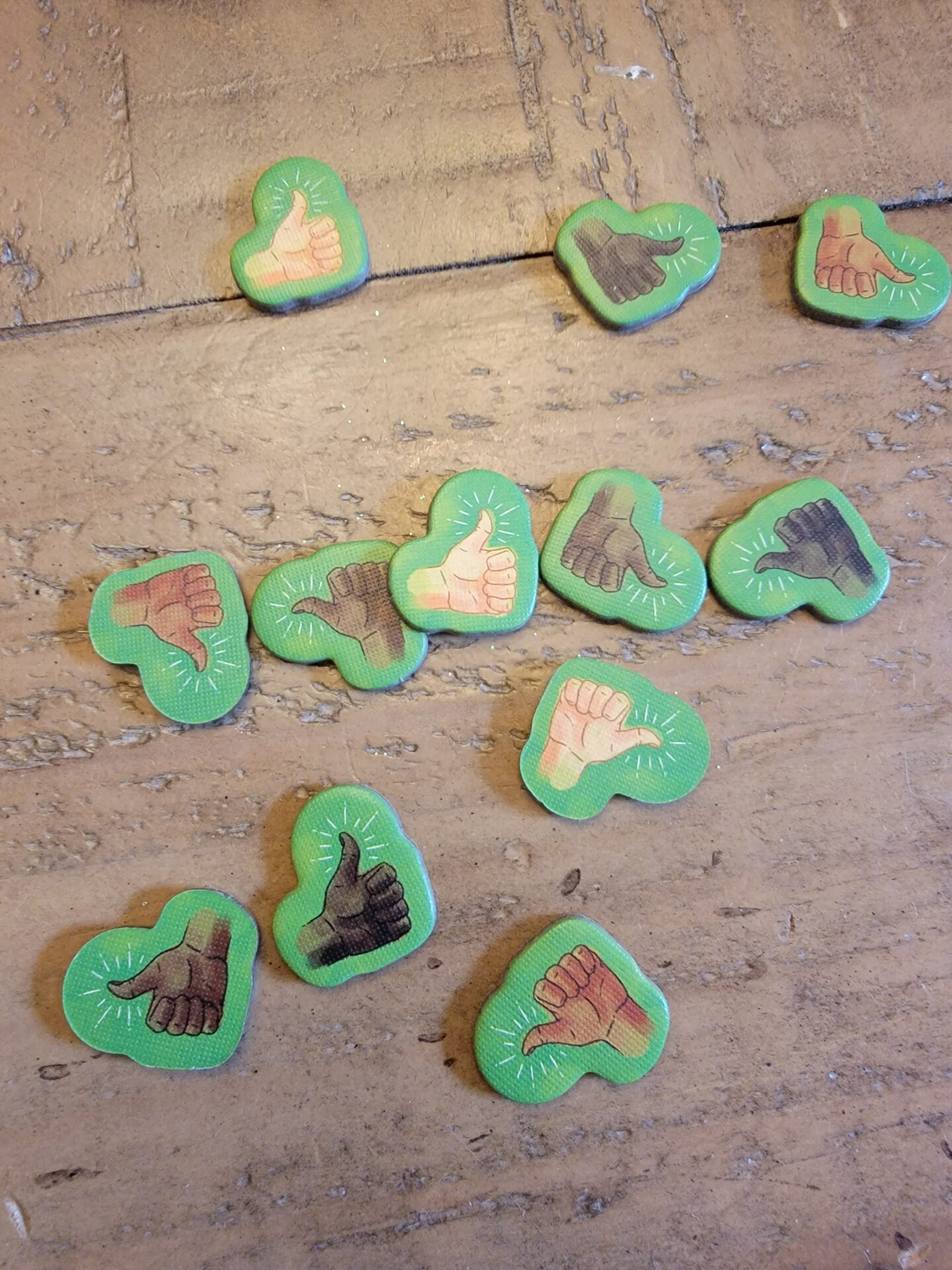
With that information, one should be able to figure out how to place their starting plant and room and hopefully score their first Verdancy Token. After this takes place, the first player is going to select cards and tokens from the market to take. Normally, a player is going to select a Plant Card and the Item or Nurture Token right below it, or they will select a Room Card and the Item/Nurture Token right above it. Once selected, the player places the new card into their grid, remembering that it has to be orthogonally adjacent to another card that has played, the cards have to alternate between plants and rooms, and the grid can be no larger than three high and five wide. The player can also immediately use the item or they can save it as each player can save a single item at a time. If the player gains another item on a later turn, they have to use one immediately and then can save the other. Item Tokens are placed in any room, though they do help you score more points if they are placed in a matching colored room. Nurture Tokens are tools that give the user added abilities to help their plants gain Verdancy Tokens quicker.
Once played, a Green Thumb Token is placed on the other card that was in the same column as the card the player chose. Then the market is re-filled and the next player goes. If a player ever chooses a card that has Green Thumb Tokens on it, then they collect these but may only have a maximum of five. These Green Thumbs allow the players to manipulate the Market, changing out cards and tiles, or even choosing a card and a tile that are not lined up with each other. Again, fans of Cascadia will know this is similar to how the Nature (Pine Cone) Tokens work in that game. Lastly, once a player gains enough Verdant Tokens on a Plant Card to Complete it, they are allowed to take the highest valued Pot Token and place it on the card. Play continues in this way until all players have completed the 3×5 grid.
On the solitaire side of things, play is practically identical though the Market does behave slightly differently. The Market acts as it is on a conveyor belt, causing the player to discard the last column’s worth of cards and tokens (including the pot) at the end of each card. Then everything slides down and the first column is refilled. This brings in two interesting points to the solitaire game. The first being that the player knows when cards and tokens are going to be discarded unlike the unpredictable nature of playing with a human opponent. The second is that the pots are also discarded and will work their way down through the values, meaning that after the first four turns, the Concrete Pots will all be discarded and so will the chance of scoring three points per each of those pots at the end of the game.
Conclusion
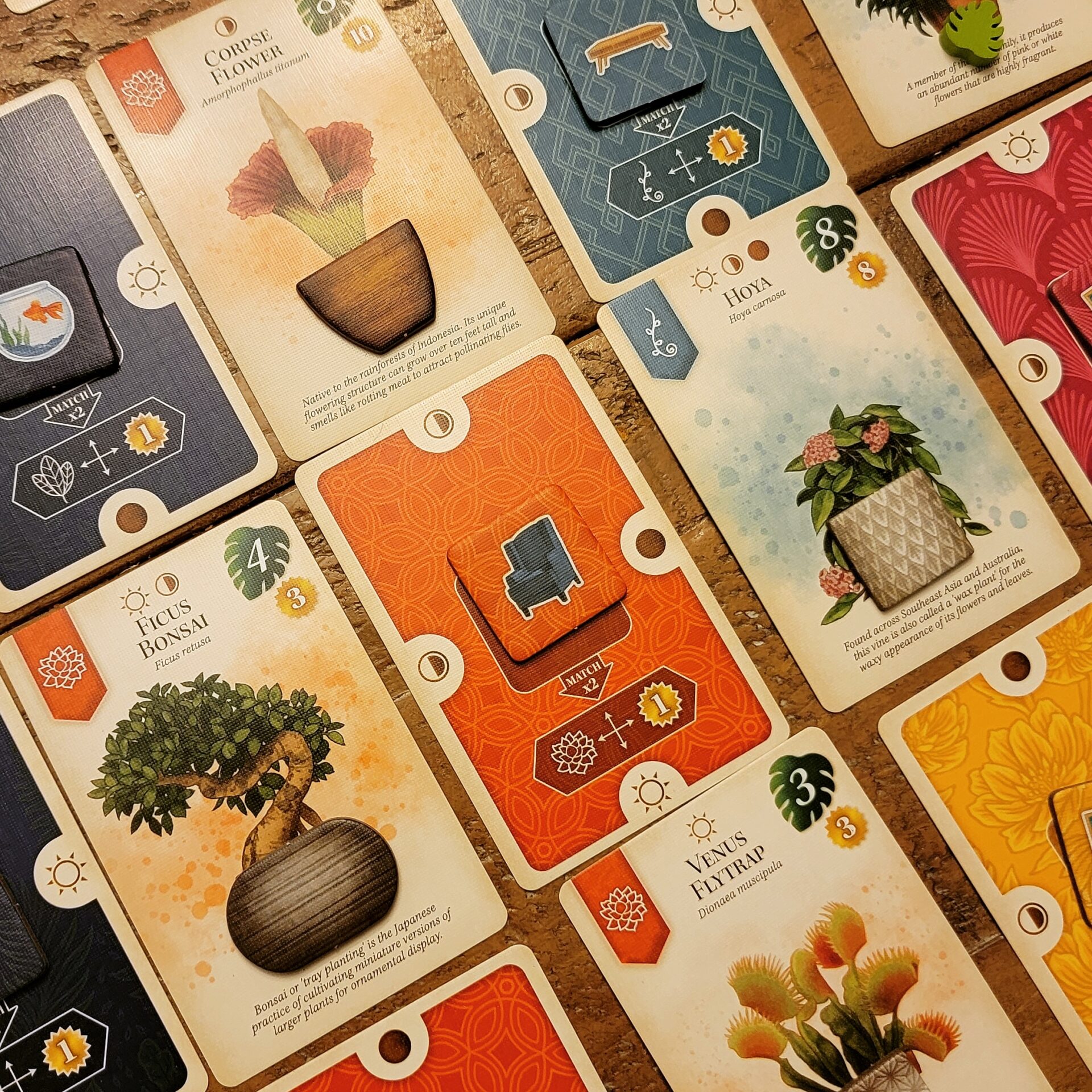
The gameplay in both versions of Verdant is as smooth as silk. The game creates a striking spatial puzzle that is easy to learn but difficult to master. In playing the solo scenarios, I can attest that some can create quite the brain burner as you try to balance getting the needed amount of points with meeting the needed requirement (such as completing all Plant Cards that you play.) Anyone who like puzzly-thinkers will definitely enjoy Verdant’s brand of card drafting and tile-placing.
If you want to know how to play the solo mode of Verdant, check out our YouTube video below!
Rating
Ratings are based on 5 main criteria: rulebook, setup, components, art & graphic design, and gameplay. The first 4 criteria are rated 1 to 5 and the gameplay is rated 1 to 10. These scores culminate in an “overall satisfaction” score that is rated from 1 to 10. If the reviewed game has both a solo and multiplayer mode, I have assigned scores separately to give context to which mode we enjoy more.
Links
As an Amazon Associate I earn from qualifying purchases.
Amazon: Verdant Board Game
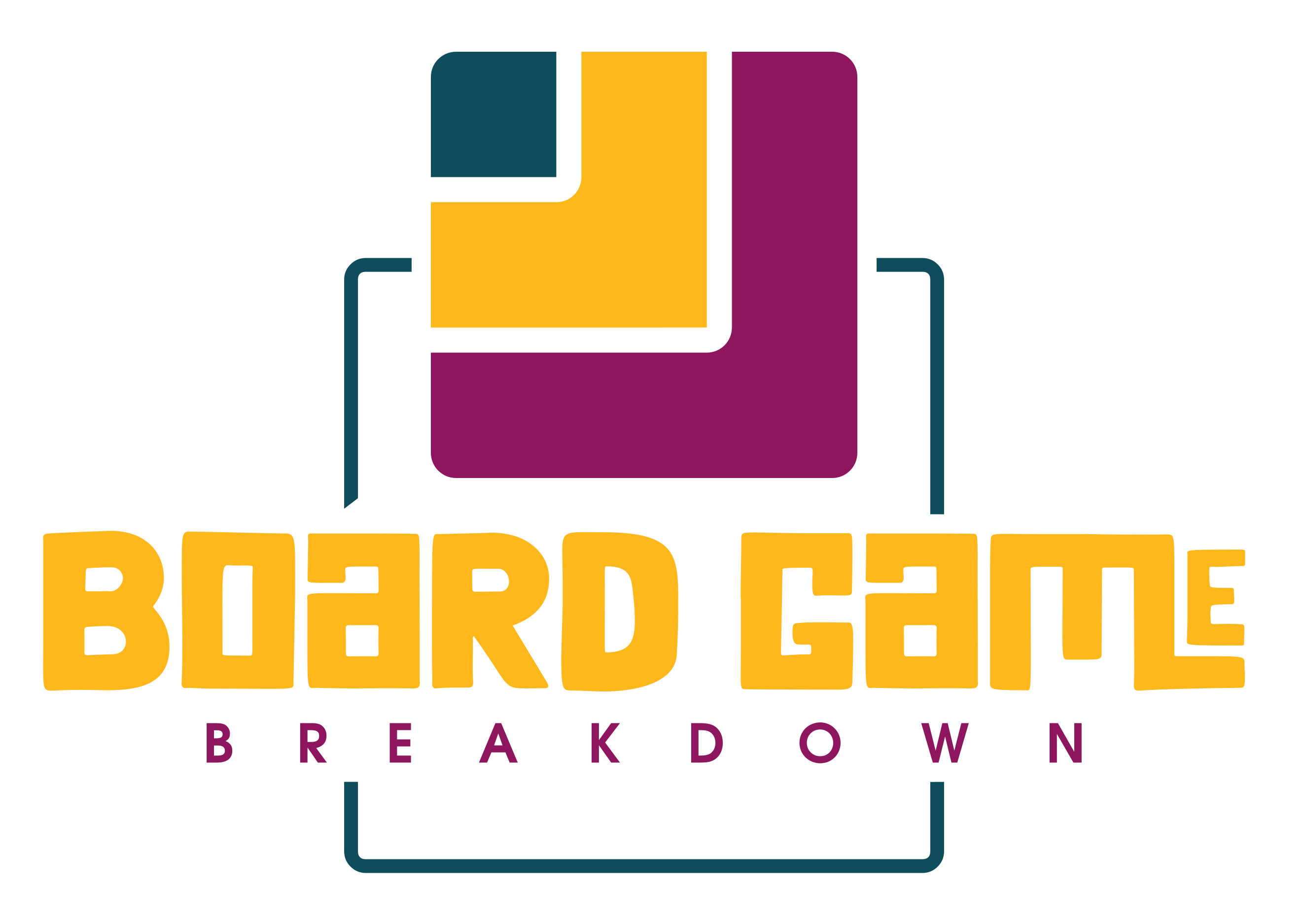
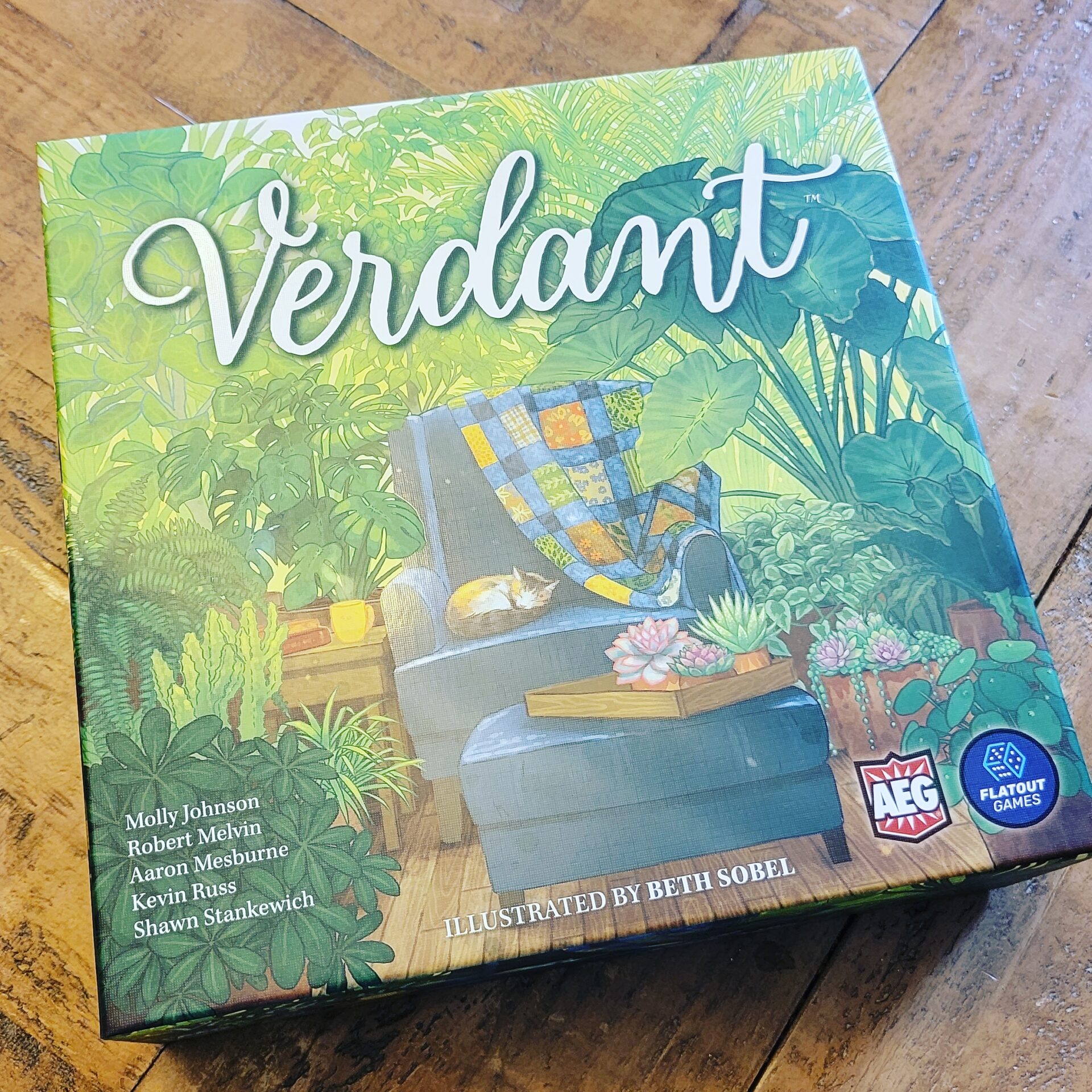
Love the review! I’ll definitely have to check it out for myself!